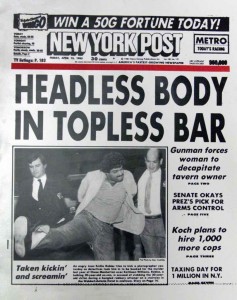 When Vincent Musetto (who wrote the infamous headline Headless body in topless bar for the New York Post) died, Media Watch ran a segment on why headlines are changing online and asked for my opinion.
When Vincent Musetto (who wrote the infamous headline Headless body in topless bar for the New York Post) died, Media Watch ran a segment on why headlines are changing online and asked for my opinion.
However, they could only run a three second quote when the answer is too complicated for that. So, in order that I can sleep at night by finally giving the full answer, here’s the main reason:
Search engines such as Google pay more attention to headlines than body copy.
This means a story is more likely to be found if the headline matches the words a searcher types into Google – which is why newspapers often run different headlines online than in print, where headlines often try to be quirky rather than explanatory.
For example, a story about the best bars in Sydney might have a headline such as “Set the bar high” for print – but when it comes to search engine optimisation (SEO), “Best bars in Sydney” will work better.
There are other reasons why online headlines tend to be more literal and descriptive than in print, however, such as:
- People read differently online and tend to only spend seconds on any given page – so if you want them to stay, you need to let them know immediately what the story is about. Usability experts find that images aren’t as important online as they are in print (with notable exceptions) and that text is more important when it comes to telling people what the content is about.
- Online copy is often divorced from the story’s images – for example, when the story’s aggregated by others, or appears in lists and feeds – and so it’s important that headlines tell the story without the aid of surrounding copy or images.
For years editors cried about how this is killing creativity in headlines … and they have a point. Steve Lohr from The New York Times once said there are no algorithms for wit, irony, humour or stylish writing, and it’s hard to imagine someone such as Musetto being happy about SEO.
Having said that, you can still create smart and even witty headlines that work well online.
Just look at Slate and Salon on any given day and you’ll see they often manage to do this by having long headlines that allow them to incorporate both the keywords that people searching on Google might use in addition to a catchy or irreverent line that gives the headline a twist. It’s a different style of headline writing, but it works well for both readers and search engines.
For example, on the day I was interviewed by Media Watch there was this headline on Salon:
“Shaving is the pits: Take up arms with Lena Dunham, Madonna and Miley in the fight against body hair oppression”
It might have been foolish of me to use this as an example for Media Watch, considering the story’s trivial nature (the show’s host made it obvious that he didn’t hold the headline in as high a regard as I do!), but then it’s not right to write a quirky or funny headline about something tragic – and so if you do want a quirky headline, you need a quirky story (or to work for a tabloid). As much as I admire the symmetry and assonance of Musetto’s “Headless body found in topless bar”, it’s not a headline I’d want to write myself, however much I respect Musetto’s abilities.
And on that note, I can’t help but link to an old 80s interview with Vincent Musetto where he explains how to write great tabloid headlines for print. It might not be useful anymore, but it is entertaining.
Learn more by enrolling in the Writing Essentials online course
Study at your own pace, whenever and wherever you want.
Taught by a former newspaper editor and journalist, this course is suited for anyone who wants to improve their writing – whether it’s for marketing, journalism, blogging or PR. It’s also ideal for those who want to improve their general writing skills.
It teaches all the basics, including:
- how to write in the active voice
- how to use positive language
- using the right tone of voice and style
- cutting copy
- making your intros stronger
- writing in plain English
- how to write in the inverted pyramid style
- top 10 news criteria (what makes a story interesting)
- frontloading content
- grammar and punctuation
- proofreading tips
- writing great headlines.
Fun and practical, this course is filled with plenty of exercises to allow you to put theory into practice.
Find out more and enrol